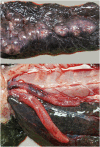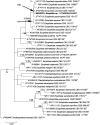A Novel Exophiala Species Associated With Disseminated Granulomatous Inflammation in a Captive Eastern Hellbender (Cryptobranchus alleganiensis alleganiensis)
- PMID: 32083105
- PMCID: PMC7004953
- DOI: 10.3389/fvets.2020.00025
A Novel Exophiala Species Associated With Disseminated Granulomatous Inflammation in a Captive Eastern Hellbender (Cryptobranchus alleganiensis alleganiensis)
Abstract
The genus Exophiala is composed of ubiquitous, pigmented, saprotrophic fungi and includes both terrestrial and waterborne species. Though Exophiala species are generally considered opportunistic pathogens, exophialosis can be an important cause of morbidity and mortality in aquatic and semi-aquatic species. Over a 6-year period, a captive 32-year-old male eastern hellbender (Cryptobranchus alleganiensis alleganiensis), was treated for recurring, slow growing, ventral midline cutaneous masses. Excisional biopsies were characterized histologically by granulomatous dermatitis with low numbers of intralesional, pigmented fungal conidia and hyphae. Bacterial and fungal cultures of the masses and skin were negative on two separate submissions. Polymerase chain reaction amplification of a short fragment of the fungal 28S large subunit (LSU) ribosomal RNA was positive with 100% nucleotide sequence identity to several species of Exophiala. Following recurrence after successive rounds of antifungal therapy, euthanasia was elected. At necropsy, similar dermal granulomatous inflammation and intralesional pigmented fungal elements as observed in excisional biopsies formed a thick band in the dermis and extended through the coelomic body wall. Visceral dissemination was noted in the lung and kidney. Postmortem DNA sequence analysis of a large portion of the fungal LSU as well as the internal transcribed spacer (ITS) from a portion of frozen affected dermis identified the fungus as a novel species, Exophiala sp. 1 (UTHSCSA R-5437).
Keywords: amphibian; chromoblastomycosis; chromomycosis; cryptobranchid; exophialosis; fungus; phaeohyphomycosis; salamander.
Copyright © 2020 Hopf, Graham, Gibas, Sanders, Mele, Fan, Garner, Wiederhold, Ossiboff and Abou-Madi.
Figures



Similar articles
-
GEOGRAPHIC AND INDIVIDUAL DETERMINANTS OF IMPORTANT AMPHIBIAN PATHOGENS IN HELLBENDERS (CRYPTOBRANCHUS ALLEGANIENSIS) IN TENNESSEE AND ARKANSAS, USA.J Wildl Dis. 2020 Oct 1;56(4):803-814. doi: 10.7589/2019-08-203. J Wildl Dis. 2020. PMID: 32544028
-
Retrospective study of phaeohyphomycosis in aquarium-housed fish, with first descriptions of Exophiala lecanii-corni and Neodevriesia cladophorae in fish.J Fish Dis. 2021 Oct;44(10):1563-1577. doi: 10.1111/jfd.13477. Epub 2021 Jun 20. J Fish Dis. 2021. PMID: 34148252
-
Characterization of the Cutaneous Bacterial Communities of Two Giant Salamander Subspecies.Microb Ecol. 2017 Feb;73(2):445-454. doi: 10.1007/s00248-016-0859-9. Epub 2016 Sep 27. Microb Ecol. 2017. PMID: 27677893
-
Cutaneous Exophiala oligosperma Infection in a Patient with Bullous Pemphigoid with a Review of the Literature.Mycopathologia. 2017 Jun;182(5-6):539-547. doi: 10.1007/s11046-016-0104-6. Epub 2016 Dec 26. Mycopathologia. 2017. PMID: 28025758 Review.
-
Chronic disfiguring facial lesions in an immunocompetent patient due to Exophiala spinifera: a case report and review of literature.Mycopathologia. 2012 Oct;174(4):293-9. doi: 10.1007/s11046-012-9548-5. Epub 2012 Jun 2. Mycopathologia. 2012. PMID: 22660887 Review.
Cited by
-
Systemic Exophiala equina infection in an Eastern box turtle (Terrapene carolina carolina): a case report and literature review.Front Vet Sci. 2023 May 12;10:1158393. doi: 10.3389/fvets.2023.1158393. eCollection 2023. Front Vet Sci. 2023. PMID: 37252397 Free PMC article.
References
-
- Junge RE. Hellbender medicine. In: Miller RE, Fowler M, editor. Fowler's Zoo and Wild Animal Medicine Current Therapy. (2012). p. 260–4.
-
- Wheeler BA, Prosen E, Mathis A, Wilkinson RF. Population declines of a long-lived salamander: a 20+-year study of hellbenders, Cryptobranchus alleganiensis. Biol Conserv. (2003) 109:151–6. 10.1016/S0006-3207(02)00136-2 - DOI
-
- New York State Department of Conservation Eastern Hellbender Fact Sheet. Available online at: https://www.dec.ny.gov/animals/7160.html (accessed January 29, 2019).
Publication types
LinkOut - more resources
Full Text Sources

